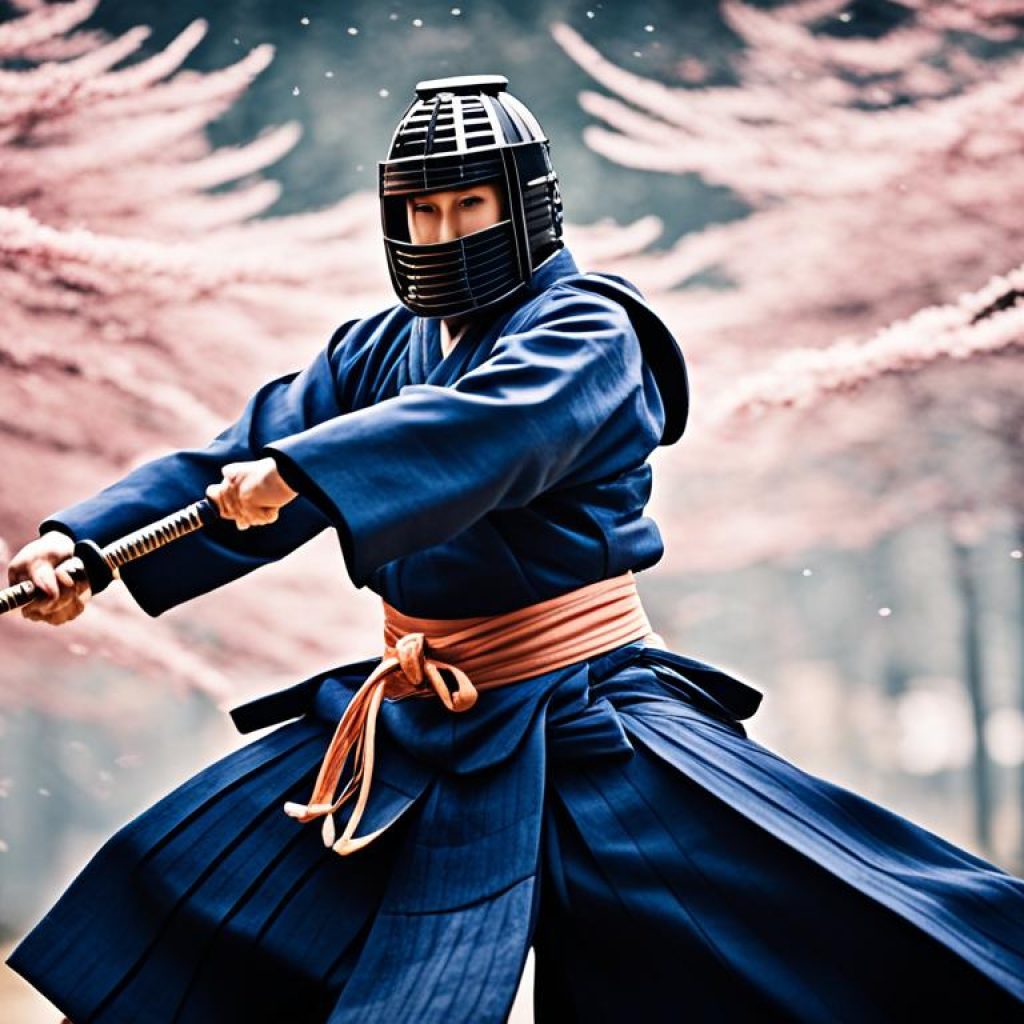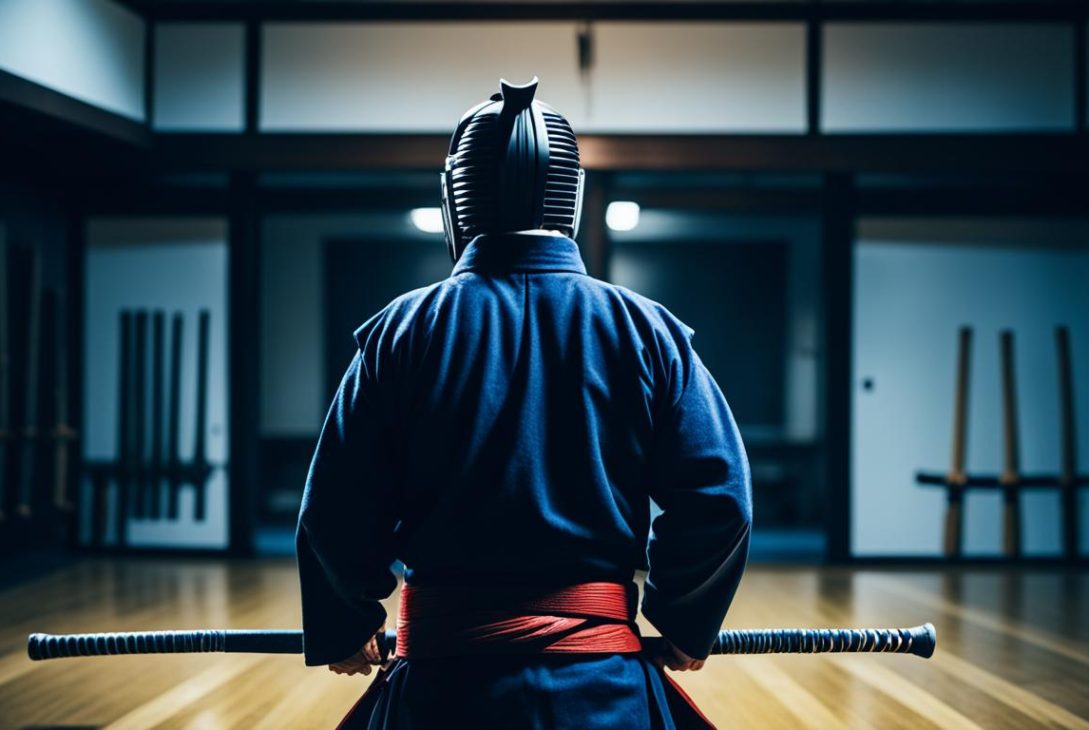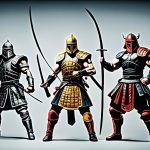Kendo, a modern Japanese martial art, has a rich history that can be traced back to medieval Japan and the ancient art of Kenjutsu. With its origins deeply ingrained in Japanese culture, Kendo has evolved over the centuries, incorporating principles of discipline and respect into a competitive sport. The practice of Kendo emphasizes the use of bamboo swords (shinai) and protective gear (bogu) to simulate combat, while focusing on precision, control, and personal growth.
Key Takeaways:
- Kendo is a modern Japanese martial art with origins in medieval Japan and the ancient art of Kenjutsu.
- Kendo emphasizes discipline, respect, and personal growth.
- The practice involves the use of bamboo swords and protective gear.
- Kendo is a competitive sport that values precision and control.
- Kendo embodies essential Japanese values and wisdom.
The Evolution of Kendo: From Samurai Blades to Bamboo Swords
The origins of Kendo can be traced back to the ancient curved samurai blade, known as the nihonto. This sword first appeared during the Heian period and was used by horsemen in northern Japan. The curved blade improved cutting efficiency and allowed for swift and accurate strikes on horseback. As the samurai adopted the design, the sword became an integral part of Japanese warrior culture. With the introduction of firearms and the Muromachi Shogunate, the focus shifted to lighter hand-to-hand combat and the development of refined swordsmanship techniques. During the Edo period, Kenjutsu continued to evolve, with the introduction of bamboo practice swords and refined protective gear.
Kendo’s history is intricately connected to the evolution of Japanese swordsmanship and the cultural changes that took place over the centuries. The transition from the traditional samurai blade to bamboo swords marked a turning point in the development of Kendo as a martial art focused on self-improvement and personal growth. The shift in equipment reflected a shift in mindset, emphasizing discipline, control, and precision over sheer force and lethality.
The Influence of Japanese Swordsmanship
The foundations of Kendo can be traced back to the ancient art of Japanese swordsmanship, known as Kenjutsu. Kenjutsu emerged during the Heian period and continued to evolve throughout Japan’s feudal era. It was a combative and practical discipline that aimed to develop highly skilled swordsmen capable of defending themselves on the battlefield.
“Kendo is not simply about victory or defeat; it is a journey of self-discovery and personal growth.” – Miyamoto Musashi
Samurai warriors played a significant role in shaping the techniques and philosophy of Kenjutsu. They valued discipline, honor, and loyalty, and swordsmanship became an integral part of their training. Over time, Kenjutsu evolved into a refined and respected art form that encompassed not only combat techniques but also the cultivation of character and the pursuit of spiritual enlightenment.
The Transition to Bamboo Swords and Protective Gear
The transition to bamboo swords, or shinai, and protective gear, or bogu, began during the Edo period. This change was driven by the need for safer training methods that would reduce the risk of injury while still maintaining the essence of swordsmanship. Bamboo, with its flexibility and resilience, proved to be an ideal material for practice swords.
The use of bamboo swords revolutionized the way Kendo was practiced. It allowed practitioners to engage in full-contact sparring, simulating real combat situations while minimizing the risk of serious injury. The introduction of bogu, which includes a helmet, chest protector, gauntlets, and shin guards, further enhanced safety by providing vital protection to vital areas of the body.
A Focus on Discipline and Personal Development
With the evolution of Kendo came a shift in focus from the physical aspects of combat to the development of one’s character and the pursuit of personal growth. Kendo emphasized discipline, respect, and self-improvement – values deeply rooted in Bushido, the samurai code of ethics.
Kendo practitioners strive for both technical mastery and spiritual enlightenment, seeing the art as a lifelong journey of self-discovery. Through rigorous training and the adherence to strict etiquette, practitioners cultivate qualities such as perseverance, humility, and mental fortitude. The discipline required in Kendo extends beyond the dojo, imparting valuable life skills that can be applied in various aspects of daily life.
| Period | Development |
|---|---|
| Heian period | Introduction of curved samurai blade (nihonto) |
| Feudal era | Evolution of Kenjutsu and the samurai warrior culture |
| Muromachi Shogunate | Transition to lighter hand-to-hand combat |
| Edo period | Introduction of bamboo practice swords and protective gear |
The evolution of Kendo from the era of samurai blades to the use of bamboo swords and protective gear marked a transformation in the practice of Japanese swordsmanship. It symbolized a shift towards a more disciplined and refined approach that focused on personal growth and spiritual development. Today, Kendo continues to flourish as a martial art that retains the essence of its historical roots while embracing contemporary values.
Kendo Philosophy and Training
Kendo, deeply rooted in the Bushido philosophy, embodies discipline, respect, and self-improvement. It goes beyond the physical aspects of martial arts, striving to refine the practitioner’s character through rigorous training.
One of the fundamental principles of Kendo is precision and control. Practitioners engage in striking techniques targeting specific areas, honing their ability to deliver accurate and controlled blows. This focus on precision fosters a sense of discipline and sharpens the mind-body connection.
The practice of Mokuso, or silent meditation, holds a central place in Kendo. It helps practitioners cultivate mindfulness and focus, enabling them to fully immerse themselves in the present moment during training and combat. By quieting the mind, practitioners can develop heightened awareness and a deep sense of concentration.
Kendo training is a comprehensive process that involves both physical and mental aspects. Through rigorous physical conditioning, practitioners build stamina, strength, and flexibility. Mental training emphasizes discipline, perseverance, and self-reflection, facilitating personal growth and character development.
“The bamboo that bends is stronger than the oak that resists.”
Kendo training is not simply about perfecting technique and winning matches. It is a holistic journey that merges the traditions of Japanese martial arts with the pursuit of personal growth. By fostering discipline, respect, and self-improvement, Kendo transcends its role as a competitive sport, becoming a path to cultivate one’s character and forge a strong mind and spirit.
| Kendo Philosophy and Training | Keywords |
|---|---|
| Rooted in Bushido | kendo philosophy |
| Precision and control | kendo training |
| Mokuso: Silent meditation | discipline |
| Physical and mental training | self-improvement |
Kendo Competitions and Ranking System
Kendo competitions are an essential element of the sport, providing practitioners with the opportunity to showcase their skills, test their progress, and engage in spirited combat. These competitions are organized and managed by esteemed organizations such as the All Japan Kendo Foundation and the International Kendo Federation. They serve as platforms where kendo practitioners from different regions and backgrounds come together to compete and celebrate the art of kendo.
The ranking system in kendo is based on dan levels, which indicate the skill and expertise of the practitioners. Dan levels start from 1st dan, representing beginners, and progress up to 8th dan, the highest rank bestowed upon the most accomplished and experienced kendoka. Each dan level signifies a milestone in a practitioner’s journey, attained through years of dedicated training, discipline, and mastery of kendo techniques.
Competitions in kendo are categorized by age and skill level, ensuring that practitioners of all ages and abilities have the opportunity to participate and experience the thrill of competitive kendo. These categories include adults, youth, and children, as well as divisions specifically for beginners and advanced practitioners.
Kendo competitions feature various formats, including individual matches and team competitions. Individual matches are intense one-on-one duels, where participants display their technical prowess, speed, agility, and strategic thinking. Team competitions highlight the collaborative and cooperative aspect of kendo, with teams of kendoka working together to outperform their opponents.
“Kendo competitions are a testament to the dedication and progress of kendoka, as they challenge themselves and push the boundaries of their skills in a dynamic and competitive setting,” says Master Takahashi, a renowned kendo instructor and former champion. He further emphasizes the importance of kendo competitions in shaping kendoka into well-rounded martial artists who embody the spirit of kendo and continuously strive for self-improvement.
| Kendo Ranking System | Description |
|---|---|
| 1st Dan | Beginner level, demonstrating foundational knowledge and techniques. |
| 2nd Dan | Intermediate level, showcasing increased skill and understanding of kendo principles. |
| 3rd Dan | Advanced level, indicating a higher level of technical proficiency and strategic thinking. |
| 4th Dan | Experienced level, characterized by refined and nuanced techniques. |
| 5th Dan | Master level, representing a deep understanding of kendo philosophy and outstanding skill. |
| 6th Dan and above | Expert level, demonstrating exceptional mastery and contributions to the kendo community. |
Participating in kendo competitions not only fosters healthy competition and camaraderie among kendoka but also serves as a crucial component of personal growth and development. It allows practitioners to challenge their limits, gain valuable experience, and build resilience and mental fortitude. Furthermore, kendo competitions promote the values of perseverance, sportsmanship, and respect for opponents, reinforcing the principles inherent in the art of kendo.
The Value of Aesthetics in Kendo
Kendo, beyond its focus on combat and technique, recognizes the significance of aesthetics in creating a harmonious and respectful environment for practitioners. The commitment to beauty and artistry extends to both the choice of equipment and the preparation of the training space, emphasizing a deeper connection with the rich cultural heritage of Japan.
Before each practice session, Kendo practitioners diligently clean the dojo, demonstrating their respect for the space and their fellow practitioners. This meticulous attention to detail fosters a sense of reverence and tranquility, fostering a harmonious environment that promotes focus and personal growth.
“Keeping the dojo clean and tidy is not just a physical act; it reflects the inner state of the practitioner’s mind and his/her commitment to the art of Kendo. Respect for the training space extends to respect for oneself and others.”
At the core of Kendo’s aesthetics is the carefully crafted equipment used in practice. Bamboo swords (shinai) and protective gear (bogu) not only prioritize safety but also embody the beauty and tradition of Japanese craftsmanship. Each piece of equipment is meticulously designed, taking into account both functionality and visual appeal, reflecting the principles of elegance and precision.

Through the cultivation of kendo aesthetics, practitioners develop a deep appreciation for the beauty and artistry of the martial art. Keeping their equipment, heart, and stance beautiful becomes an integral part of their training, symbolizing strength of mind and a commitment to continuous improvement.
The Aesthetics of Kendo Equipment
| Equipment | Functionality | Beauty |
|---|---|---|
| Bamboo Sword (Shinai) | Simulates the weight and feel of a real sword while ensuring safety during practice | Intricately bound bamboo slats symbolize the artistry of traditional Japanese craftsmanship |
| Protective Gear (Bogu) | Provides essential protection for practitioners during rigorous training | Harnesses intricate patterns and designs, showcasing the fusion of art and function |
By maintaining the aesthetic integrity of their practice, Kendo practitioners cultivate an environment that nurtures not only physical strength but also a deeper sense of appreciation for beauty, respect, and the profound cultural heritage that Kendo represents.
Embracing Propriety and Respect in Kendo
Propriety and respect are integral to Kendo, reflecting the deep-rooted values of Japanese culture. Practitioners of Kendo express their reverence through a series of bowing rituals that hold profound significance. Bowing is an essential element practiced when entering and leaving the dojo, before and after each session, and even before engaging in combat with opponents. The precision and grace of these bows convey sincerity and respect towards others, fostering an environment of mutual appreciation and camaraderie.
Furthermore, Kendo follows a set of prescribed gestures known as shosagoto, which serve as a testament to the discipline and propriety encompassed within the martial art. These gestures emphasize efficiency, rationality, and consideration for others. Each movement carries a deliberate purpose, enhancing both the physical and mental aspects of the practitioner’s journey. By adhering to these expressions of respect in Kendo, individuals develop a strong foundation for harmonious interactions and mutual understanding both within the dojo and in their daily lives.
Within this context of respect and propriety, the act of bowing takes on great significance. It transcends mere formality and becomes a genuine demonstration of reverence and humility. Bowing in Kendo is a symbol of acknowledging and embracing the internal and external aspects of oneself, as well as showing appreciation for the teachings of the art and its practitioners.
“Bowing is the humble acknowledgment of our shared pursuit for self-improvement and mutual respect in the world of Kendo.”
Through bowing and the practice of shosagoto, Kendo practitioners cultivate a deeper understanding of the values that underpin the martial art. These practices not only foster respect for others but also enhance self-discipline and promote personal growth.
Summoning Courage and Confidence in Kendo
Kendo practitioners must possess immense courage and confidence, both on and off the training ground, to face the challenges they encounter. In the world of Kendo, one powerful technique that aids in the summoning of these essential qualities is known as Kiai.
Kiai, a loud shout emitted before striking an opponent, serves a twofold purpose in Kendo. Firstly, it is a means of intimidation, aiming to unsettle adversaries and disrupt their concentration. Secondly, and perhaps more significantly, Kiai draws out the practitioner’s inner strength, fostering a deeper connection between the mind, body, and technique.
The act of Kiai requires practitioners to tap into their reserves of courage, as it demands the ability to overcome fear and uncertainty. It is not easy to face higher-ranked teachers or skilled opponents, yet the experience gained through such encounters is invaluable in building confidence and self-assurance.
“Kiai is the embodiment of our spirit in Kendo. Through it, we express our determination, strength, and unwavering commitment to the art.” – Sensei Takashi Nakamura
By channeling their kendo courage and confidence into Kiai, practitioners not only enhance their combat effectiveness but also develop a strong sense of self-belief that extends far beyond the confines of the dojo.
Finding Inner Strength through Kiai
The act of Kiai is a deeply personal experience, as it requires practitioners to connect with their innermost emotions and harness the energy within. When performed with conviction, Kiai can instill a sense of empowerment and fortitude, allowing practitioners to push their limits and reach new levels of achievement in Kendo.
- Kendo courage, rooted in discipline and mental fortitude, enables practitioners to confront their fears head-on.
- With each Kiai, practitioners develop a profound belief in their abilities and overcome self-doubt, fostering kendo confidence.
- Kendo courage and kendo confidence complement one another, forming the bedrock of a practitioner’s mental resilience.
Through continuous training and the practice of Kiai, Kendo practitioners cultivate not only physical strength but also an unwavering sense of self-belief that permeates all aspects of their lives.
Embracing Humility and Discipline in Kendo
Kendo embodies the virtues of humility and self-discipline, challenging practitioners to transcend the confines of rank and ego. While titles and ranks hold significance, true mastery lies in cultivating humility and respect for others regardless of their standing. In Kendo, judgment based solely on rank is discouraged, and practitioners are reminded of the importance of bowing down, both literally and figuratively, as they progress in their training.
These principles of humility and discipline extend beyond the dojo, enriching interpersonal relationships and fostering empathy and compassion. By internalizing these values, practitioners cultivate a mindset of continuous improvement and dedicate themselves to the pursuit of self-mastery.
“In the beginner’s mind, there are many possibilities; in the expert’s mind, there are few.”
These insightful words from Zen master Shunryu Suzuki beautifully capture the essence of humility in Kendo. By adopting a beginner’s mind, free from preconceptions and judgments, practitioners open themselves to limitless growth and learning.
Kendo Hierarchy and the Path to Humility
The Kendo hierarchy, symbolized by the dan ranking system, serves as a framework for measuring skill and progress. However, the true value of this hierarchy lies not in its exclusivity, but in the lessons it imparts about humility and respect.
Regardless of their rank, Kendo practitioners are encouraged to approach every interaction with a humble and open mindset. Instead of seeing higher-ranked practitioners as superior, they view them as mentors and sources of inspiration. Through this mindset, practitioners learn to appreciate the depth of knowledge and experience that each individual brings to the art.
Fostering Discipline through Rigorous Training
Discipline is at the core of Kendo, reflected in its rigorous training methods. As practitioners immerse themselves in the training process, they learn to embrace discipline both on and off the training ground.
The daily practice of Kendo demands dedication, perseverance, and self-control. Long hours of repetitive strikes, footwork drills, and intense sparring sessions cultivate resilience and mental fortitude. This disciplined approach not only nurtures physical strength and agility but also instills important life skills such as time management, goal-setting, and self-motivation.
The Role of Senpai and Kohai in Kendo
In addition to the dan ranking system, Kendo follows an informal hierarchy known as the senpai-kohai relationship. Senpai refers to more experienced practitioners, while kohai refers to those with less experience.
This relationship is built on mutual respect and support. Senpais guide and mentor their kohais, fostering a sense of camaraderie and collective growth. Kohais, on the other hand, show respect and gratitude to their senpais, acknowledging their role in their own development.
| Rank | Description |
|---|---|
| 4th dan and above | Experienced practitioners regarded as senior members of the Kendo community. |
| 1st to 3rd dan | Intermediate-level practitioners who have gained a solid foundation in Kendo. |
| 1st kyu | Advanced beginners who have achieved a high level of technical proficiency. |
| 7th to 2nd kyu | Beginners who are still developing their skills and understanding of Kendo. |
The senpai-kohai relationship transcends the hierarchical structure of ranks, emphasizing the importance of mutual support and the passing down of knowledge from one generation to the next.
By embracing humility and discipline, Kendo practitioners embody the true spirit of the martial art. These virtues shape not only their journey in Kendo but also their approach to life, guiding them towards personal growth, self-discovery, and a deeper connection with others.
Conclusion
Kendo martial arts is not just a physical practice; it is a journey of personal growth and self-discovery. Through the practice of kendo, individuals can embrace essential Japanese values and wisdom that transcend cultural boundaries.
By immersing themselves in the art of kendo, practitioners can cultivate mindfulness, appreciate the aesthetics of their surroundings, and embrace propriety and respect. The focus on precision and control in kendo fosters discipline and self-improvement, allowing individuals to develop their character and foster personal growth.
Beyond the training ground, the principles of kendo extend into everyday life, enriching interpersonal relationships and fostering meaningful connections. The courage and confidence developed in kendo empower practitioners to face challenges head-on, while humility and discipline remind them to cultivate empathy and respect for others.
Through the essence of kendo martial arts, individuals can lead more fulfilling and purposeful lives, guided by the timeless wisdom of centuries-old traditions. By embracing Japanese values and delving into the transformative journey of kendo, practitioners can embark on a path of self-discovery, personal growth, and profound connection with themselves and others.
FAQ
What is Kendo martial arts?
Kendo is a modern Japanese martial art that focuses on swordsmanship. It emphasizes the use of bamboo swords and protective gear to simulate combat while emphasizing precision, control, and personal growth.
What are the true origins of Kendo?
Kendo traces its origins back to medieval Japan and the ancient art of Kenjutsu. It evolved over the centuries, adapting principles of discipline and respect into a competitive sport.
What is the history of Kendo?
Kendo’s origins can be traced back to the curved samurai blade, known as the nihonto, which appeared during the Heian period. Over time, Kendo evolved with the introduction of bamboo practice swords and refined protective gear.
What are some common Kendo techniques?
Some common Kendo techniques include strikes targeting specific areas, known as “yuko datotsu.” These strikes focus on fostering precision and control.
How is Kendo training approached philosophically?
Kendo training is rooted in Bushido, the samurai code of ethics. It emphasizes discipline, respect, and self-improvement, with the practice of Mokuso, silent meditation, being an integral part of the training.
Are there Kendo competitions and how is ranking determined?
Yes, Kendo competitions are an important part of the sport. They are categorized by age and skill level, and practitioners follow a ranking system based on dan levels, with higher ranks indicating greater skill and expertise.
What is the significance of aesthetics in Kendo?
Kendo places a strong emphasis on aesthetics in the choice of equipment and the preparation of the training environment. Practitioners believe that keeping their equipment, heart, and stance beautiful leads to strength of mind.
How is propriety and respect demonstrated in Kendo?
Propriety and respect are integral to Kendo, expressed through bowing rituals and prescribed gestures. Bowing is done to show respect towards the dojo, fellow practitioners, and opponents. These gestures emphasize efficiency, rationality, and consideration for others.
How does Kendo help practitioners summon courage and confidence?
Kendo requires practitioners to summon their courage and confidence to face challenges both on and off the training ground. The practice of Kiai, a loud shout before striking an opponent, helps draw out their inner strength and build confidence.
How do humility and discipline play a role in Kendo?
Kendo embodies the virtues of humility and self-discipline. True mastery is achieved by cultivating humility and respect for others, regardless of rank. Judgment based solely on rank is discouraged, fostering humility and discipline.
Source Links
- https://www.martialartswords.com/blogs/articles/beginners-guide-to-japanese-kendo
- https://workmill.jp/en/webzine/kendo-japan-values/
- https://www.ancient-origins.net/history-ancient-traditions/kendo-0019512
https://uwmta.org/martial-arts-styles.html
Japanese Swordsmanship Kendo Equipment Kendo History Martial Arts Origins Samurai Tradition Sword Fighting Techniques Traditional Japanese Sports Zen Influence in Kendo
Last modified: April 11, 2024




